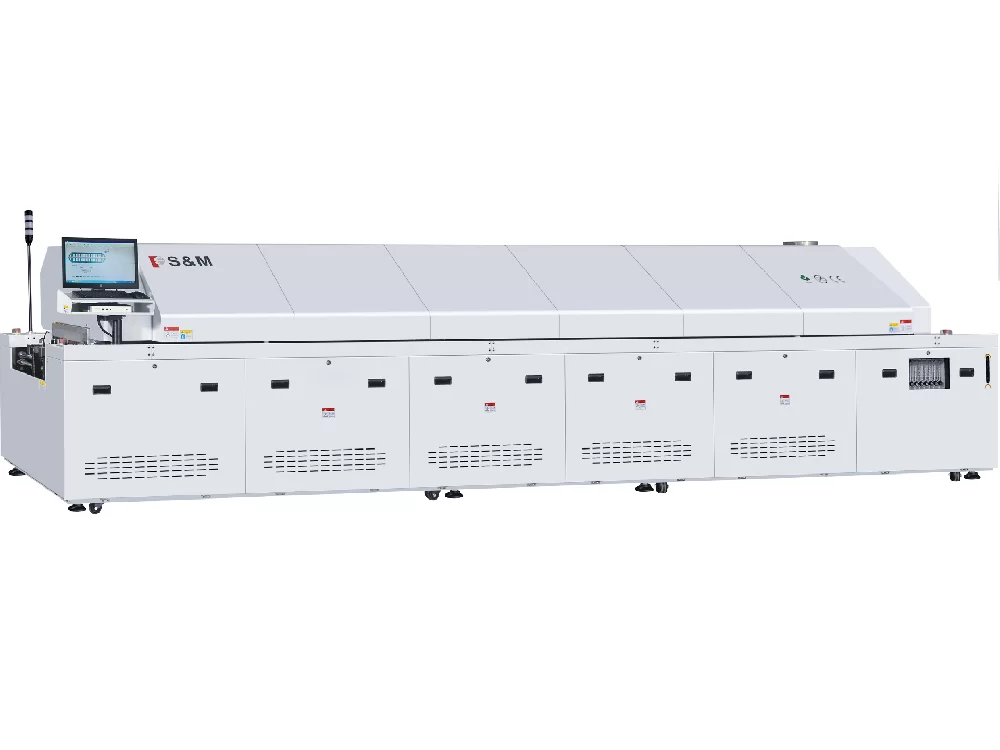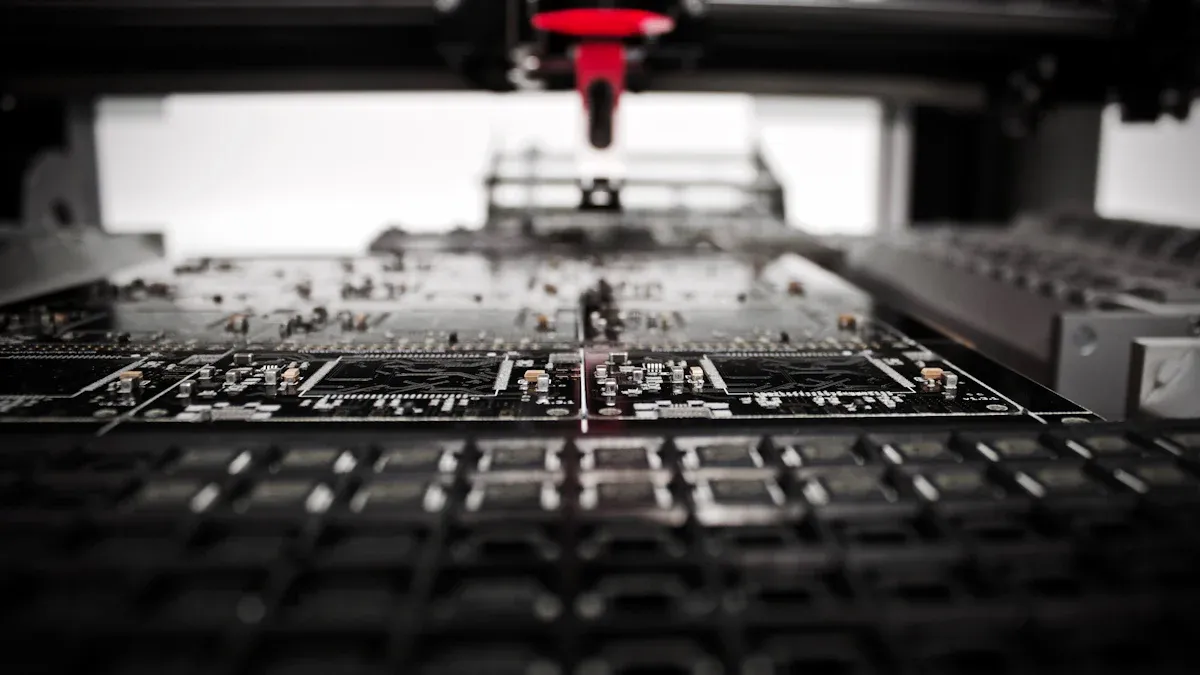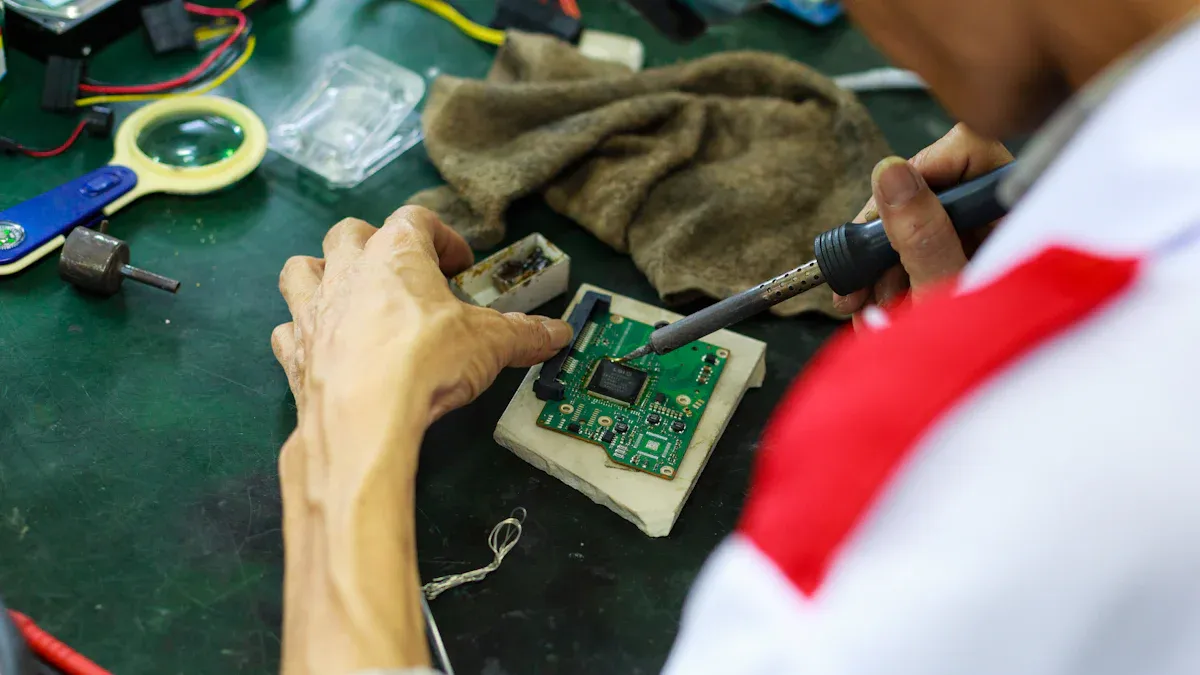
Choosing the right reflow oven for your SMT line is important. It can change how well your products turn out. About 30% of SMT problems happen because of bad reflow soldering. This often happens when you use the wrong oven or set it up badly.
|
Cause of SMT Production Defects |
Approximate Percentage (%) |
|---|---|
|
Stencil Printing |
53 |
|
Component Placement |
17 |
|
Improper Reflow Soldering & Raw Material Flaws |
30 |
You can make soldering better by picking an oven with good thermal profiles. Good gas flow control also helps a lot. Advanced ovens lower the number of mistakes. They help you spend less on fixing problems. They also help you make more good products.
Key Takeaways
-
Pick a reflow oven that controls temperature well. This helps make strong solder joints and lowers mistakes.
-
Choose an oven size that fits your biggest boards. Make sure it can handle your busiest days. This keeps your line working well.
-
Find ovens with many heating zones. This lets you control heat at each step. It helps make better soldering.
-
Use ovens with smart features like real-time checks and alarms. These save time and help you avoid errors.
-
Clean and take care of your oven often. This keeps it working well and helps you find problems early.
Why Reflow Oven Choice Matters

Production Quality
You want every board to work well. The right reflow oven helps you do this. If your oven is not right, you may have problems like:
-
Tombstoning happens when a part stands up because of uneven heat.
-
Component shifting is when parts move because solder melts unevenly.
-
Weak solder joints can happen if the temperature is not controlled.
-
Voids and solder balls come from heat that is not balanced.
These problems often start with ovens that do not heat evenly. Good ovens have zones for preheating, soaking, reflow, and cooling. Each zone keeps the heat steady. Convection ovens use moving hot air for even heating. They work better than infrared ovens. When you control each zone’s temperature, you stop many problems. This also makes solder joints strong and reliable.
Tip: Clean and check your oven often. This keeps your boards good and lowers mistakes.
Efficiency & Cost
Picking the right reflow oven saves time and money. Here are some ways a good oven helps you:
-
Real-time thermal checks let you skip extra steps. This saves about 20 minutes each time.
-
Fast oven startup means you can start sooner. This saves 10-15 minutes each time.
-
Automated setup and changeover cut downtime. This saves up to 30 minutes each time.
-
Less maintenance is needed because of constant checks. This keeps your line running longer.
-
Quick fixes for heat problems stop wasted boards and lost parts.
-
Automated records help you track quality and get money back if things go wrong.
A reflow oven with automatic checks, real-time data, and easy setup keeps your line moving. You spend less time fixing and more time making good boards. Even heating and nitrogen options lower defects and make soldering better. This means fewer repairs and more profit.
Note: One extra hour of work each week can add thousands of dollars to your profit each year, especially if you make a lot of boards or expensive ones.
Selection Criteria

Oven Size & Capacity
Pick an oven that fits your work needs. If you make small batches or test boards, a small oven saves space and power. For lots of boards, use a bigger oven with more heating zones. This lets you make more boards at once and fit larger PCBs.
|
Production Volume |
Oven Type / Zones |
Typical Board Size |
|---|---|---|
|
Single or dual hot plate; no zones |
N/A |
|
|
12-15 boards/day |
Batch oven, single zone |
N/A |
|
~100 boards/day |
Conveyorized 3-zone oven |
Up to 12″ x 12″ |
|
Over 100 boards/day |
Multi-zone ovens (zones vary with speed and volume) |
Up to 12″ x 12″ or larger |
A big oven with many zones gives you more control. It also helps you make more boards faster. Always check the biggest PCB your oven can hold. Make sure it fits your largest boards. If your boards are heavy or bendy, look for board support systems to keep them steady.
Tip: Pick an oven that fits your largest PCB and busiest day. This stops slowdowns and keeps your line moving.
Heating Zones
Heating zones help you solder well. Each zone lets you set the heat for each step—preheating, soaking, reflow, and cooling. More zones mean you can control the heat better. This is very important for lead-free soldering, which needs careful heat control.
-
Ovens with 8 or more zones let you work with tricky boards and different solder pastes.
-
More zones let you set the right heat for each step, so you get fewer problems like solder balls or cold joints.
-
With a 5-zone oven, you might need to slow down the conveyor to get the right heat, which can lower how many boards you make.
-
An 8-zone oven helps you keep up with faster work and new board designs.
Always check the heat profile your solder paste supplier suggests. Set your oven zones to match. This helps you avoid problems and keeps your solder joints strong.
Temperature Control
Good temperature control makes soldering better. You want your oven to keep each zone at the right heat, with little change. New ovens use smart controls like PLC and PID systems. These keep the heat steady and the same every time.
|
Control Parameter / Technology |
Purpose / Effectiveness |
|
|---|---|---|
|
Pre-heat Zone |
Ramp rate 1.5°C–3°C/sec |
Avoids stress, balances evaporation |
|
Soak Zone |
Flat temperature, 150–170°C |
Uniform heating, activates flux |
|
Reflow Zone |
Peak 25–30°C above melting |
Proper solder melting, avoids damage |
|
Cooling Zone |
Controlled 2–5°C/sec |
Prevents cracks, ensures strong joints |
Look for ovens with real-time checks, alarms for heat changes, and easy software. The VS-1003-N uses Siemens PLC and PID closed-loop control. This keeps the heat right within ±1°C, which is great for lead-free work.
Note: Always test your boards in real work settings. This helps you find hot or cold spots and fix your settings for the best results.
Conveyor & Transport
The conveyor moves your boards through the oven. A good conveyor keeps boards steady and stops them from bending. You can pick rail, mesh, or hybrid conveyors.
|
Support and Handling Characteristics |
Suitable PCB Types |
Impact on Throughput and Handling |
|
|---|---|---|---|
|
Rail Conveyor |
Grips edges, strong support |
Heavy, double-sided |
High accuracy, less warpage |
|
Mesh Conveyor |
Supports whole board, even heating |
Large, flexible |
Uniform heating, easy cleaning |
|
Hybrid Conveyor |
Adjustable width and speed |
Mixed types |
Flexible, efficient changeovers |
Rail conveyors are good for heavy or double-sided boards. Mesh conveyors work well for big or bendy boards. Hybrid systems give you the most options. Adjustable rails and speeds help you handle different board sizes and keep up with changes. The VS-1003-N has a two-stage multi-point guide rail and adjustable speeds, so it fits your needs.
Energy Efficiency
Energy efficiency saves money and helps the planet. New ovens use smart heat control, insulation, and energy-saving systems. These cut down on power use and keep your shop cooler.
-
Energy-saving ovens lower your power bills and costs.
-
Good insulation and heat recovery keep more heat inside, so you use less energy.
-
Smart controls and automation stop energy waste when the oven is not working or changing jobs.
-
Using less energy means less pollution, which is good for the environment.
Some ovens, like the VS-1003-N, use advanced gas control to improve hot gas flow and heat balance. This makes them more efficient and keeps soldering steady. When you pick an energy-saving oven, you save money and show you care about the environment.
Tip: Add up your energy savings, faster work, and fewer mistakes to see how much an efficient oven is worth in the long run.
Reflow Oven Evaluation
Uniformity & Stability
You want every board to be the same quality. To do this, you must check if the oven heats evenly. Use thermocouples for this test. Put them across the board’s width and length. This shows if the heat spreads everywhere. You can use a metal-clad FR-4 or aluminum board for testing. Run the board through the oven and write down the temperatures.
Here is an easy way to check if the oven heats evenly and stays steady:
-
Put thermocouples in different spots on the board.
-
Run the board through the oven and note the hottest temperatures.
-
Do the test a few times to see if the results match.
-
Look for the hottest and coldest spots on the board.
Watch the oven while you do these tests. Make sure the fans and heaters work well. If you see big temperature changes or hear odd sounds, there may be a problem.
|
Description |
|
|---|---|
|
Noise Level |
Virtual profile accuracy is close to real profiles, showing little noise. |
|
Reliability Monitoring |
Automated SPC checks for problems early by watching key specs. |
|
Fault Detection |
Alarms warn you about faults so you can fix them fast. |
|
Process Stability |
Real-time checks and SPC charts keep your process steady and recorded. |
|
Quality Assurance |
Alarms for Cpk and temperature changes help you stay in control. |
|
Data Traceability |
Time-stamped records and alarms let you track how things went. |
Good airflow and multi-zone heating help keep your process steady. These features stop defects and make boards more reliable. Always check your oven after you fix it or if the room changes.
Tip: Test your oven often to catch problems before they hurt your boards.
Smart Features
Modern reflow ovens have smart features that help you work better. Look for ovens with PLC and PID controls. These keep the temperature steady, usually within ±1°C. This means you get fewer mistakes and stronger solder joints.
Smart ovens often include:
-
A PC and Siemens PLC system for steady temperature.
-
PID controllers in each zone for quick changes.
-
A Windows interface with many languages, so it is easy to use.
-
Passwords and automatic logs for better safety and tracking.
-
Online editing, so you can change settings without stopping the oven.
-
Automatic cooling if there is an alarm, to protect your boards.
-
UPS backup to keep the oven safe if the power goes out.
You also get alarms for things like temperature changes, speed issues, or board jams. These alarms warn you early, so you can fix problems fast. Some ovens let you scan barcodes to load the right recipe, which helps stop mistakes. You can even watch and control the oven from far away, so your line keeps running.
Note: Smart features help you save time, make fewer mistakes, and keep your process steady.
Maintenance & Support
Taking care of your reflow oven is important for smooth work. You need to get spare parts and help easily. Top brands have a worldwide network for parts and service. You can get manuals, updates, and even new parts quickly. Many companies offer phone and email help, so you get answers fast.
Training is also very important. With new ovens, you can learn to use them in just two hours. Training from the maker helps you use all the oven’s features. It teaches you how to set up boards, recipes, and keep the oven working well. Good training means less waiting and better boards.
Look for ovens with modular designs. These make fixing and cleaning faster and easier. If you can swap parts quickly, you spend less time waiting and more time making boards.
Tip: Keep learning and get help when you need it to get the best from your reflow oven.
Model Comparison & ROI
Feature Comparison
When you look at reflow ovens, you will see they are different. There are two main types: horizontal and vertical reflow ovens. Each type is good for different factories. The table below shows how they are not the same:
|
Feature/Aspect |
Horizontal Reflow Oven |
Vertical Reflow Oven |
|---|---|---|
|
Air Circulation |
Horizontal cyclone convection |
Vertical convection |
|
Temperature Uniformity |
High, even across PCB |
Good, but less uniform |
|
Heating Zones |
3 top & 3 bottom zones |
Up to 10 stacked zones |
|
Flux Management |
Simple, less residue |
Complex, more cleaning needed |
|
Nitrogen Usage |
Lower |
Higher |
|
Equipment Complexity |
Simple, easy maintenance |
More complex, higher upkeep |
|
Space Needed |
Larger footprint |
Smaller footprint |
|
Operational Cost |
Lower |
Higher |
Pick a model that fits your space, board size, and speed. Horizontal ovens are best for big boards and lots of work. Vertical ovens take up less room and have more heating zones for different jobs.
Cost Analysis
How much a reflow oven costs depends on how many boards you make and what you need it to do. The table below shows the usual price ranges:
|
Production Scale |
Typical Cost Range (USD) |
Key Features |
|---|---|---|
|
Small |
$5,000 – $20,000 |
Basic controls, manual loading |
|
Medium |
$20,000 – $50,000 |
Conveyor, better temperature control, data logging |
|
Large |
$50,000 – $150,000+ |
Multi-zone, advanced automation, high throughput |
If you only make a few boards, you can use a simple oven. If you make more boards, you need more zones and better controls. This helps you keep quality high and waste low. Spending more on a good oven can save you money later by stopping problems and delays.
Tip: Make sure the oven’s features match what you need. This helps you get the most for your money.
Vendor Support
Good vendor support helps your oven work well for a long time. Here are some things to look for:
-
Quick help with problems and easy-to-find spare parts.
-
Training so your team knows how to use the oven.
-
Regular checkups and fast repairs to keep things running.
-
Remote help and advice to make your work better.
-
Service plans that cover fixes and updates.
Strong vendor support keeps your oven working longer and stops costly breaks. It also helps you get better soldering and make more money.
Note: Pick a vendor with good support. This keeps your oven safe and your work smooth.
When picking a reflow oven, look at how well it controls heat. Check if it has special air settings and if it works without breaking often. Make sure the oven size and features fit your work. Smart ovens help you watch quality and waste less. They also make your work faster and better. You can find problems more easily and have fewer mistakes. Talk to experts for help with settings, testing, and care. The right reflow oven helps your business grow and keeps your products good.
FAQ
What is the most important feature to look for in a reflow oven?
You should focus on temperature control. Good temperature control helps you get strong solder joints and fewer defects. Ovens with PLC and PID systems give you steady heat for better results.
How do I know if my oven size is right for my production?
Check your largest PCB size and your busiest production day. Pick an oven that can handle both. If you plan to grow, choose a model with extra capacity.
Why does my oven need multiple heating zones?
Multiple zones let you set different temperatures for each step. This helps you avoid problems like solder balls or weak joints. You get better quality and more control.
How often should I maintain my reflow oven?
You should clean and check your oven every week. Regular maintenance keeps your oven running well and helps you catch problems early.
Tip: Set a reminder for oven checks. This keeps your SMT line working smoothly.
